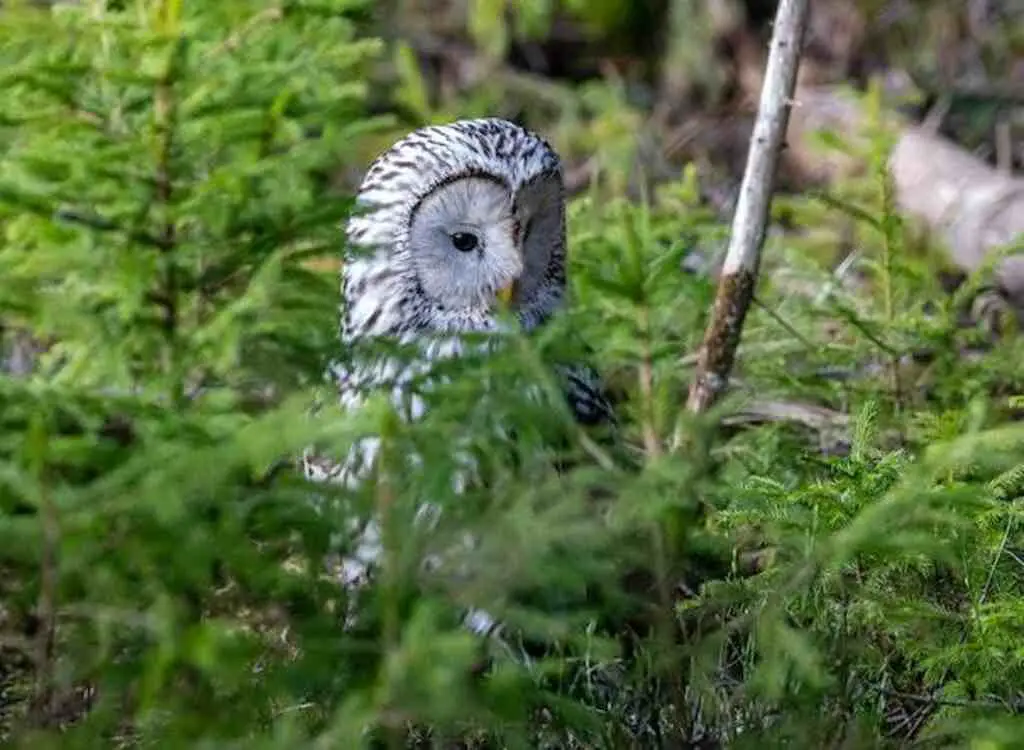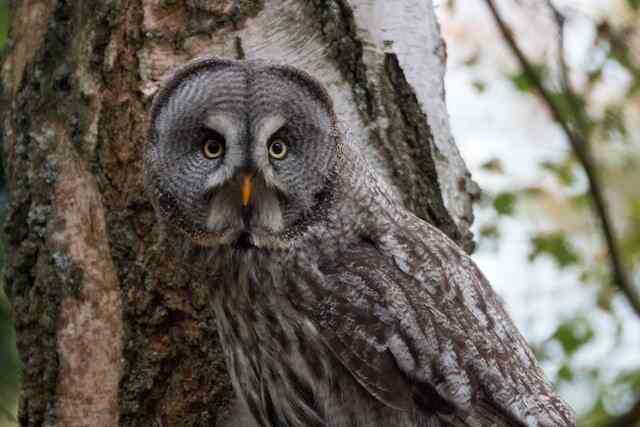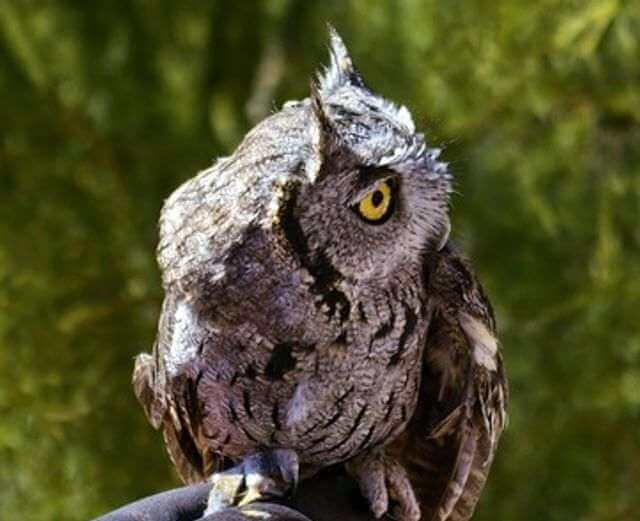Do Owls Eat Plants? The short answer is no, but that’s not the whole story. Owls are fascinating creatures known for their incredible hunting abilities and mysterious behavior. Yet, despite their sharp talons and beaks, some people still wonder if these feathered predators munch on some leafy greens.
In this article, we’ll explore the reasons behind owls’ meat-only diet and how it affects their survival in the wild. So, if you’re curious about the eating habits of these intriguing birds, keep reading to uncover the truth about owls and their relationship with plants.
Table of Contents
Do Owls Eat Plants?
Owls are known for their sharp talons, keen eyesight, and silent flight. They are also known for their carnivorous diet, which primarily consists of other animals. Nevertheless, certain types of owls have been seen consuming small quantities of plant matter, particularly fruits.
| Plant | Owl Species | Season |
|---|---|---|
| Acorns | Great Horned Owl, Northern Spotted Owl, Barred Owl | Fall |
| Berries | Eastern Screech Owl, Northern Saw-whet Owl | Fall |
| Cactus | Elf Owl, Western Screech Owl | Summer |
| Chamomile | Long-eared Owl, Short-eared Owl | Summer |
| Clover | Great Gray Owl, Snowy Owl, Short-eared Owl | Spring |
| Corn | Barn Owl, Great Horned Owl | Fall |
| Crabapple | Great Gray Owl, Snowy Owl | Winter |
| Dandelions | Barn Owl, Great Horned Owl, Eastern Screech Owl | Spring |
| Fir Trees | Northern Pygmy Owl | Year-round |
| Grasses | Barn Owl, Long-eared Owl, Short-eared Owl | Spring/Summer |
| Juniper Berries | Western Screech Owl, Northern Saw-whet Owl | Winter |
| Pine Nuts | Northern Pygmy Owl, Northern Spotted Owl | Fall |
| Sagebrush | Long-eared Owl, Short-eared Owl, Great Horned Owl | Winter |
| Seeds | Barn Owl, Great Gray Owl, Snowy Owl | Year-round |
| Wildflowers | Barn Owl, Great Gray Owl, Snowy Owl | Spring/Summer |
Carnivorous Diet
Owls are primarily carnivorous, which means they survive on a diet of meat. They are skilled hunters and will eat a wide variety of prey, from small insects such as moths or beetles to large birds, even as large as an Osprey.
Ketupa and Scotopelia species, which are predominantly found in Asia and Sub-Saharan Africa, respectively, mainly feed on fish. These species of owls are commonly referred to as fish-owls and fishing-owls, respectively.
The owls’ diet is determined by their species and geographic location. Insects such as beetles, mice, shrews, voles, and crayfish are typically consumed by smaller owls.
Conversely, larger owls have a diverse range of prey, including rodents, raccoons, cats, small dogs, rabbits, squirrels, small deer, bats, falcons, and even other owls.
Types of Prey
Owls hunt mainly at night, using their exceptional hearing and eyesight to locate prey. Opportunistic in nature, these hunters have a dietary habit of consuming whatever is within their reach. Some of the most common types of prey that owls hunt include:
- Rodents: Owls are particularly fond of rodents such as mice, voles, squirrels, and rats. These small mammals make up a significant portion of their diet.
- Bats: Owls are also known to hunt bats, which are active at night, just like owls. They are agile fliers, but they are no match for the owl’s silent flight and sharp talons.
- Insects: While not a significant part of their diet, owls will eat insects such as beetles, moths, crickets, spiders, centipedes, and scorpions.
- Small mammals: Owls will eat a variety of small mammals, including moles, shrews, and other small animals that are active at night.
- Other birds: Owls are known to hunt and eat other birds, including other owls.
- Reptiles and amphibians: While not a significant part of their diet, owls will eat reptiles and amphibians such as snakes, lizards, and frogs.
Overall, while owls are primarily carnivorous, some species have been observed consuming modest amounts of plant materials, notably fruit. However, the vast majority of their diet consists of other animals that they hunt at night using their exceptional senses.
Owls and Their Prey
Owls are known for their hunting skills and their ability to consume a wide range of prey. They are primarily carnivorous, and their diet consists mainly of small mammals, birds, reptiles, amphibians, fish, and invertebrates. Owls have a unique hunting behavior that enables them to capture their prey with ease.
Hunting Behavior
Owls are nocturnal hunters and are well adapted to hunting in low light conditions. They have excellent eyesight and can detect prey from a distance. They also have the ability to turn their heads up to 270 degrees, which allows them to scan their surroundings for potential prey.
Once they spot their prey, they use their sharp talons to capture and kill it. Owls also have the ability to fly silently, which makes them excellent ambush predators.
They swoop down on their prey without making any noise, which gives their prey very little chance to escape. Owls are also known to swallow their prey whole and regurgitate pellets of fur and bones.
Food Consumption
Owls consume a wide variety of prey, ranging from small insects to larger mammals. Some of their favorite prey include rodents, moths, beetles, crickets, spiders, and other invertebrates. They are also known to consume live prey, such as birds and small mammals.
The amount of food that an owl consumes depends on its size and the availability of prey. Larger owls, such as the Great Horned Owl, can consume up to three times their body weight in a single day. Smaller owls, such as the Screech Owl, consume less food and may only eat a few small mammals or insects per day.
Overall, owls are skilled hunters that consume a wide variety of prey. Their unique hunting behavior and excellent eyesight make them effective predators, and their ability to consume live prey and regurgitate pellets of fur and bones allow them to survive in a wide range of environments.
Types of Owls
Owls are a diverse group of birds, with over 200 species found worldwide. Each species has its own unique characteristics, including size, color, habitat, and diet. While some owls share similar traits, others have very distinct features that set them apart from the rest.
Barn Owls
With the exception of Antarctica, Barn owls can be found on every continent, making them one of the most widely distributed owl species. They are known for their heart-shaped face and pale, buff-colored feathers.
Barn owls are nocturnal hunters that feed primarily on small mammals such as rodents, shrews, and bats. In addition to consuming mammals, they are recognized for their diet that includes birds, reptiles, and insects.
Great Horned Owls
Great horned owls are one of the largest owl species in North America, with a wingspan of up to five feet. They are easily recognizable by their distinctive ear tufts and yellow eyes. Great horned owls are apex predators that feed on a wide variety of prey, including rabbits, squirrels, skunks, and even other birds of prey.
Burrowing Owls
Burrowing owls are small owls that are found in grasslands and deserts of North and South America. They are known for their long legs and tendency to live in underground burrows. Burrowing owls feed primarily on insects, but they will also eat small mammals, birds, and reptiles.
Barred Owls
Barred owls are medium-sized owls that are found in forests across North America. Their unique hooting call is a defining characteristic, resembling the sound of “Who cooks for you? Who cooks for you-all?” Barred owls feed primarily on small mammals such as mice, voles, and rabbits, but they will also eat birds, reptiles, and amphibians.
Snowy Owls
Snowy owls are large, white owls that are found in the Arctic regions of North America and Eurasia. They are well adapted to life in the cold, with thick feathers and large, powerful talons. Snowy owls feed primarily on lemmings, but they will also eat other small mammals, birds, and fish.
Small Owls
There are several species of small owls, including the eastern screech owl, the northern saw-whet owl, and the pygmy owl. These owls are typically less than ten inches tall and are found in a variety of habitats, from forests to deserts. Small owls feed primarily on insects, but they will also eat small mammals, birds, and reptiles.
Larger Owls
In addition to the great horned owl, there are several other species of larger owls, including the Eurasian eagle owl, the African spotted eagle owl, and the Ural owl. These owls are apex predators that feed on a wide variety of prey, including mammals, birds, and reptiles.
Overall, while owls are known for their hunting prowess, they are not known to eat plants. Instead, they are strict carnivores that rely on a diet of meat to survive.
Owls and Their Environment
Habitat
Owls are found all over the world, except for Antarctica. They are adaptable birds and can live in a variety of environments, including forests, deserts, and grasslands.
The type of habitat an owl lives in will affect its appearance, behavior, and diet. For example, the snowy owl is found in the Arctic tundra, and its white feathers help it blend in with the snow and ice.
Most owls are nocturnal, meaning they are active at night, and they prefer to live in areas with plenty of trees for roosting and nesting.
Owls are also territorial birds and will defend their nesting sites from other owls.
Seasonal Changes
Owls, like many animals, are affected by seasonal changes. In the winter, when food is scarce, some owls will migrate to warmer areas in search of prey. For example, the snowy owl will migrate southward from the Arctic in search of food during the winter months.
During the winter months, owls that live in areas with snow on the ground will have to adapt to their environment. For example, the great grey owl will hunt for prey under the snow, using its keen hearing to locate rodents scurrying beneath the surface.
Diet
Owls are carnivorous birds and primarily eat small mammals, such as rodents, rabbits, and squirrels. They also eat birds, reptiles, and insects. Owls are apex predators, meaning that they are at the top of the food chain in their environment.
Contrary to popular belief, owls do not eat plants. They are strictly carnivorous and do not have the digestive system to break down and extract nutrients from plants.
Overall, owls are adaptable birds that can live in a variety of environments. They are affected by seasonal changes and will migrate or adapt to their environment in search of food.
Owls are carnivorous and primarily eat small mammals, such as rodents and rabbits.
Owl Predators
Owls are formidable predators, but they are not invincible. There are several predators that pose a threat to owls, including hawks, eagles, and other raptors.
Hawks are one of the main predators of owls. They are fast and agile, and they can swoop down on an owl before it has a chance to react.
They are also known for their sharp talons, which they use to catch and kill their prey. Some of the hawks that are known to prey on owls include the Cooper’s hawk, the sharp-shinned hawk, and the red-tailed hawk.
Eagles are another predator that can pose a threat to owls. Eagles are larger and more powerful than hawks, and they are known for their sharp beaks and talons.
They are also very fast and can cover a lot of ground quickly. Some of the eagles that are known to prey on owls include the golden eagle and the bald eagle.
Other raptors, such as falcons and ospreys, can also prey on owls. These birds are known for their speed and agility, and they can catch an owl off guard if it is not paying attention.
Despite the threats posed by these predators, owls are still very successful hunters. They have excellent eyesight and hearing, and they are able to fly silently through the night, making them very difficult to detect.
However, even the most skilled hunters can fall prey to a predator if they are not careful.
Owl Adaptations
Owls are fascinating creatures that have evolved over time to become highly specialized hunters. Their unique adaptations allow them to thrive in a variety of environments, from dense forests to open grasslands. Here are some of the key adaptations that make owls such effective predators.
Feathers and Flight
One of the most striking features of owls is their feathers. These specialized structures are designed to help owls fly silently, allowing them to swoop down on unsuspecting prey without being heard. The edges of their feathers are serrated, which helps to break up the air currents that cause noise.
Additionally, owls have larger wings relative to their body size than most other birds, which gives them exceptional maneuverability in the air.
Eyes and Vision
Owls are known for their incredible eyesight, which allows them to hunt in low light conditions. Their eyes are large and forward-facing, giving them excellent depth perception and the ability to judge distances accurately.
Additionally, owls have a high concentration of light-sensitive cells in their retinas, which allows them to see in very dim light.
Some species of owl have eyes that are so large that they cannot move them in their sockets, so they must turn their entire head in order to look around.
Beaks and Talons
Owls have powerful beaks and talons that are designed for hunting and killing prey. Their beaks are sharp and curved, which allows them to tear flesh easily. Their talons are long and sharp, with curved tips that help them grip onto their prey.
Additionally, some species of owl have a reversible outer toe, which allows them to grasp onto branches and other surfaces with two toes in the front and two in the back.
Overall, owls are highly specialized predators that have evolved a variety of adaptations to help them hunt and survive in their environments.
From their silent flight to their incredible eyesight, every aspect of an owl’s anatomy is designed to make them one of the most efficient hunters in the animal kingdom.
Owl Pellets
When it comes to studying the diet of owls, owl pellets are an important tool for researchers. Owl pellets are not droppings, but rather the indigestible parts of an owl’s prey that are regurgitated in the form of a compact pellet.
These pellets can provide valuable information about the types of prey an owl consumes, as well as the health and condition of the owl itself.
Owls produce pellets because they cannot digest the fur, bones, and other non-digestible parts of their prey. Instead, these parts are formed into a pellet in the owl’s gizzard, which is then regurgitated.
The size and composition of an owl pellet can vary depending on the size and type of prey consumed. Dissecting owl pellets can be a fascinating and informative activity for both children and adults.
By examining the contents of a pellet, one can identify the types of prey consumed by the owl. Small bones, teeth, and other remains can often be identified using a magnifying glass or microscope.
It’s not just owls that produce pellets, though. Many other birds of prey, such as hawks and eagles, also produce pellets.
In fact, some non-predatory birds, such as doves and pigeons, also produce pellets. However, owl pellets are the most well-known and widely studied type of pellet.
Conclusion
In conclusion, owls are primarily carnivorous and survive on a diet of live prey, especially rodents. While certain owl species have been observed consuming modest amounts of plant materials, notably fruit, plants and fruits can’t provide them with the proper energy to live. Therefore, the priority is to prey.
Owls are nocturnal feeders and crepuscular, meaning they are most active during the night and at dawn or dusk. They are also known for their exceptional hearing and teeth that are adapted for catching and killing prey.
Owls play an important role in the ecosystem by controlling rodent populations, which can have a significant impact on the food chain. They are also a mystery to many people, with their silent flight and piercing eyes.
Overall, while owls may occasionally eat plants, their diet is primarily made up of live prey, making them an important predator in many ecosystems.










